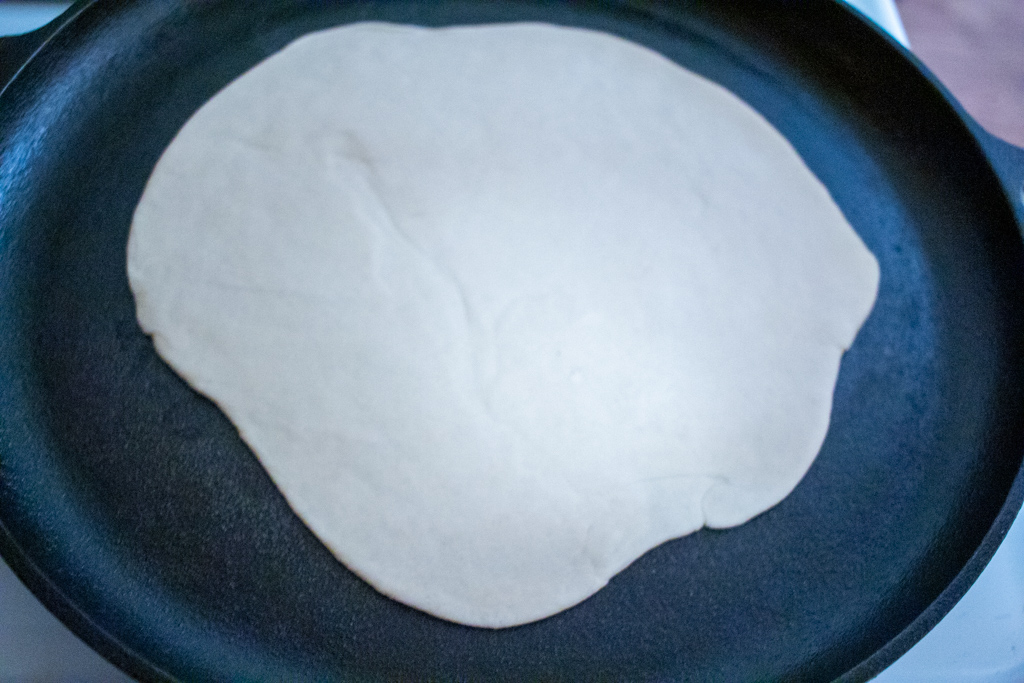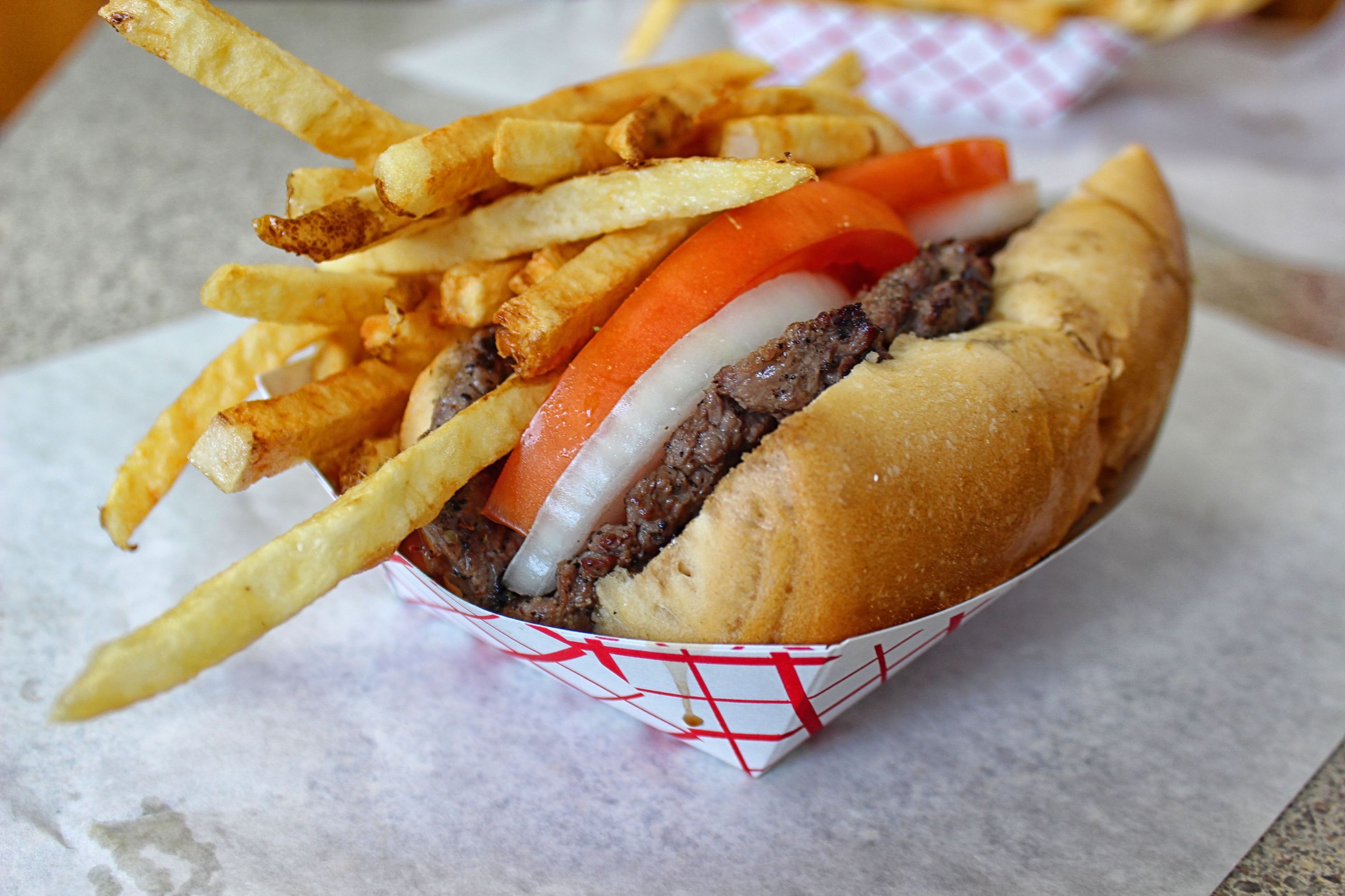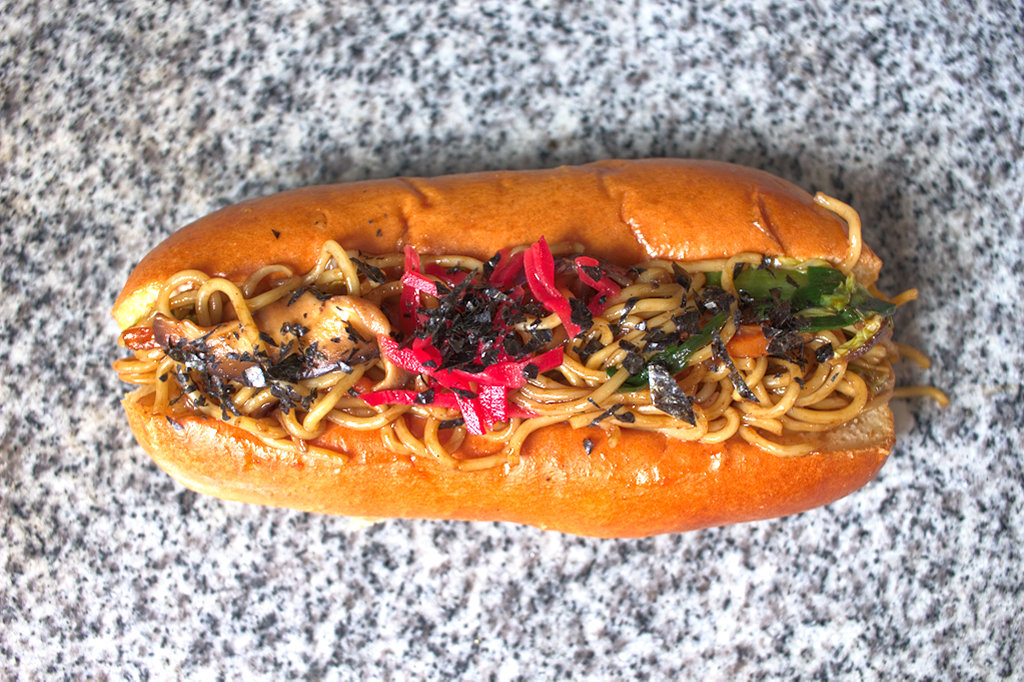Piadina Romagnola: The Italian Taco?
No not really, not at all even, please put down the pitchforks. Sometimes I stretch too far looking for a theme each month.
And yet…
A piadina (plural: piadine) is an Italian flatbread. Minimally chemically leavened if at all, it is much like a thick flour tortilla. These flatbreads are baked on a heated flat terracotta dish I’ve seen called teggia or testo, or sometimes Montetiffi after a place known for making them. The still-warm piadine are made at home as a simple, quick snack, or served as a street food, folded around a number of savory or sweet fillings. They range from very thin to a couple millimeters thick, with blistered brown to black spots appearing on their surface while they are griddled. According to Google Image Search, a filled piadina looks something like this:

That looks to me like a ham taco. Are ham tacos a thing? Only to us gringos, it seems? But why? There are ham tortas after all. This is important, as Christmas is coming and there will be leftover ham for days and I am definitely feeling an urge toward making ham tacos. Important note: it is now after Christmas and I did not in fact make any tacos with leftover Christmas ham. I did, however, make a very tasty omelet.
First, though: piadina Romagnola. It has existed in its current form since at least 1371 when it was mentioned in writing by Cardinal Anglico de Grimoard. Historically the food of the poor, quickly and easily made on ordinary days to supplement the leavened bread that might only be baked weekly, it has found champions in both poets and politicians. 19th Century Italian poet Giovanni Pascoli famously wrote a poem La Piada in 1909 praising it as the bread of those who work. Il poco è molto a chi non ha che il poco, he wrote, which Google translates as “A little is a lot to those who have little,” a familiar thought to many of us, perhaps.
Over the course of the 20th Century, the flatbread gained popularity as a street food in and around the Romagna area of northern Italy. Post-WWII, the production of piadina has been industrialized, and packaged commercial versions are available all over Italy to be reheated and filled. Many still choose to make them by hand though. Piadina uses a low-hydration but fatty dough, traditionally containing lard for a softer, thicker flatbread. Nowadays many piadina makers use olive oil instead for a thinner, more cracker-like (not to mention vegetarian) bread.
Extra virgin olive oil is delicious and I’m sure would make a fine flatbread but when it comes to the fat of choice for breadmaking… make mine lard.

The piadina dough recipes I worked with this month called for a low-ish level of hydration–44-50%–but between the additional fat and a rest to relax the glutens the resulting dough was quite pliable. After separating the dough into balls of 110 to 150 grams each, I rolled each ball out and cooked it immediately while keeping the other ones tightly covered to prevent them from drying out.

The piadine are finicky to cook correctly. The griddle should be hot enough to brown and blister them nicely, even to the edge of giving them black spots. Moving them around on the griddle and poking any bubbles that develop with a fork helps them to cook more evenly. However, if the surface cooks too hard, the resulting piadina will lack flexibility and crack when wrapping around your tasty filling of choice. I never really found the exact sweet spot, but for the thickness to which I was rolling these, 2 minutes per side on the griddle seemed to be about right.



They are meant to be served while still hot, so I experimented with starting to fill them while they were still on the griddle. I’m not sure this was the best way to go about things and subsequent versions were assembled on the same marble surface where I make so many of my sandwiches. Doing it while on the griddle did give the cheese a nice head start on melting though.

The first one I made combined capocollo with Calabrese salami, Fontina and Grana Padano Parmesan cheeses, arugula and olive oil.

Unfortunately he piadina was cooked too long and cracked when I tried to bend it. With this version, and with many of those to follow, I cut it into wedges to share with my family. The arugula and olive oil combination seems to be a common way to dress salumi in a piadina based on some of the stories and filling ideas I’ve read. The peppery/mustardy flavor of the arugula is a good match for Italian cured meats, as is the pungent nuttiness of Fontina.




Another common combination is prosciutto with Squacquerone or Stracchino cheese, arugula and olive oil. Squacquerone and Stracchino are both young, mild, spreadable cheeses, and where they are unavailable, many recipes suggest ricotta as an alternative. This made for a great combination, the fresh milky ricotta just barely warmed by the still-hot piadina, given depth by the intense salty funk of the prosciutto and the arugula.




Piadine are frequently served for breakfast as well, combining various meats with eggs and vegetables. For my breakfast piadina I scrambled an egg with diced tomato, covered that with fresh-grated Grana Padano parmesan, and combined this with prosciutto and basil leaves.




This was an intensely savory breakfast, the tomatoes, prosciutto, parmesan, even the eggs all rich sources of umami, set off nicely by the sweetness of the basil leaves.

Probably my best idea for filling the piadine I made this month was combining sweet Italian sausage–Chicago-style, not spicy but redolent of fennel seed–with broccoli rabe sauteed with garlic and dried chili peppers and a sharp imported provolone. Obviously this was inspired by the famous roast pork sandwiches of Philadelphia but the sweet Italian sausage instead of the roast pork gives it a more aromatic character and shifts the balance back toward the broccoli rabe and cheese. I just wish I’d gotten the cheese meltier.




Of course the classic Caprese salad is a perfect piadina filling, this one using a fresh bufala mozzarella made from the more interesting, slightly tart milk of the Italian water buffalo. Even without the usual addition of balsamic vinegar this was a winning combination.




Tuna is another common filling for piadine. Here I combined Callipo brand tuna in olive oil with finely diced onion and celery, chopped marinated artichoke hearts, boiled egg, and just enough mayonnaise to bind them together, then dressed the tuna with shredded lettuce, sliced tomato, and a mixture of balsamic vinegar, white wine vinegar, olive oil, and dried herbs.




The tuna mix was about as good a tuna salad as it’s possible to make–some hot giardiniera would have improved it, but I was saving that for my last attempt at a savory piadina.
So, do you have a favorite sandwich? I don’t, not really. When people ask me what my favorite sandwich is, I usually reply with “the one in front of me.” Good for a laugh, and true for the most part. We are out here, after all, to “enjoy every sandwich.”
But if there was going to be a sandwich named after me, my best chance at sandwich immortality is probably my slight variation on the Chicago-style Italian sub. “Chicago-style what?” you may ask, and it’s true. Chicago doesn’t need to have its own style of everything. But there is a distinct local twist to that most universal of sandwiches, as explored by a group of local food writers back in 2010, as photographically documented on the terse but eloquent Chicago food site Grease Freak.
The sandwich itself is fairly straightforward, usually a combination of salami, capocollo, and mortadella, with provolone cheese, shredded lettuce dressed with oil and vinegar, and sliced tomato. The best ones (in my personal opinion) are served on 9″ lengths cut from the 4′ long baguettes made by Damato’s bakery on Grand Ave. Giardiniera is a must, and part of what makes it a Chicago-style sub. You can order one just about anywhere in town and while you might not receive a transcendent sandwich you will probably get one that’s pretty good. Pretty damn good.
My own version of it though swaps out the mild domestic version of provolone for a sharper, stinkier imported version. I ask for prosciutto to be added. And of course, the giardiniera must be hot giardiniera. The resulting sandwich takes what is a pleasant, well-balanced combination of Italian cured meats with bread and vegetables and turns it into a palate-hammering combination of intense flavors overlaid on that initial well-balanced sandwich. It’s not an everyday sandwich, but it is a fun one to have on occasion. J. P. Graziano, who makes my favorite version of it in the city, has yet to put it on the menu as the Jim B but knows it’s me when I order one.

So I made one using a piadina as the shell instead of that great Damato’s bread. The provolone was a “picante” domestic version rather than the sharp imported version, which I could not get in a sliceable form at my local Italian deli, but it would do for this rendition.

Most sub makers will not use the version of mortadella containing pistachios in their sandwiches due to nut allergies, which is sensible of them, accommodating to those with dietary restrictions. I have no such restrictions when making this sandwich at home.

The capocollo I used was a mild version rather than hot, but…

The salami I used was a hot Calabrese, bright red from copious inclusion of Calabrian peppers.

Finally, the crowning glory of this or any other sandwich, Prosciutto di Parma. The good stuff. Though Jamon Serrano is my favorite of the dry-cured European hams I will never turn my nose up at this classic either.

To this perhaps over-thick stack of Italian meats I added some of my own homemade giardiniera.

Then the vinaigrette-dressed lettuce and sliced tomatoes that must garnish any Chicago Italian sub.

My Italian sub piadina was quite a handful. More hefty than I had imagined, I think. The addition of prosciutto throws off the balance of an Italian sub as I had mentioned, but the removal of bread removes any semblance of balance whatsoever.

Some more lettuce might have helped, as would using less cheese. Perhaps though limiting the number of meats in a piadina to one or two as the Italians do is better yet, rather than completely filling the surface of the flatbread with multiple layers of meat and cheese like the fat American I am.

It was so good though. Glad to have tried it, though nothing will ever replace that extra-long Damato’s bread for me.
In addition to the various savory applications for piadine, many sites suggest using a simple filling of Nutella to make a sweet piadina. This may have been the most popular one served in my house.



Many cultures have similar flatbreads–Mindy just brought home some gräddat from IKEA this afternoon in fact–and these types of bread lend themselves naturally to being used either as a scoop, as with pitas and hummus or naan and curry; or as a wrap. Gyros, souvlaki, shawarma, burritos and tacos (even French Tacos), various types of kebab: all of these are in the same family of sandwich-like foods as this delightful Italian version. Each of them though is unique, each presenting its own varied delights. Piadina Romagnola is no more a taco than a doner kebab is a burrito, and we’re glad there are so many unique and delicious street foods in this world.
Thank you for reading–whether you’re a new reader or have been with the Tribunal from the beginning, we appreciate you. This wraps up the year 2021 for us–another tough one finally in the books. While we’re hopeful for brighter days ahead, those hopes are tempered with a good-sized dash of pessimism. Still, there are still plenty of new (to us) and tasty things for we have yet to discover, and as big as this world is, maybe we’ll never run out. See you next year!

I like sandwiches.
I like a lot of other things too but sandwiches are pretty great











Recent Comments